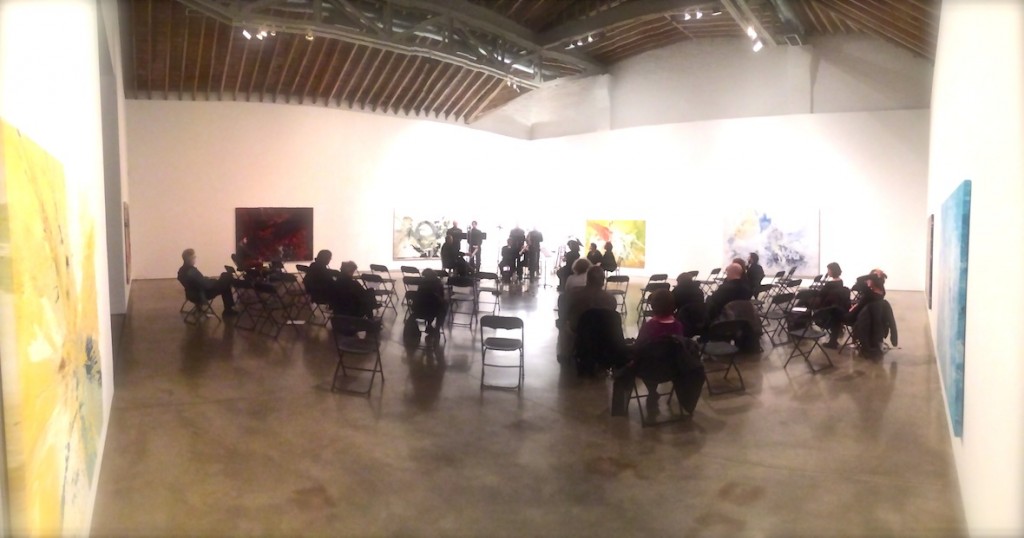Kotik’s “Many Many Women” proves a timeless five-hour journey

Petr Kotik and the S.E.M Ensemble performed Kotik’s five-hour “Many Many Women” Friday night at the Cooper Gallery. Photo: G. Grella
In the fall of 2012, to honor the centennial of John Cage’s birth, Petr Kotik organized and led a magnificent “Beyond Cage” festival that featured the U.S. premieres of two Morton Feldman orchestral works and a performance of Cage’s Atlas Eclipticalis that will never be surpassed. One of the special events was to be a full-length concert of Kotik’s own epic composition, Many Many Women. But then Hurricane Sandy came and pushed the Hudson River into the concert site, the Paula Cooper Gallery, and a truncated performance was organized at a gallery in Brooklyn.
Now, in what felt like the belated real ending to last year’s festival, Kotik and the S.E.M. Ensemble musicians played the full version of the work in an uncanny and affecting Friday performance Friday night at the Cooper Gallery.
Many Many Women comes out of a specific time and place, when Cage’s inspiration by Buckminster Fuller and Finnegan’s Wake was ascendant, and any musician could collaborate with Morton Feldman, Julius Eastman and other composers at the University at Buffalo. But the music sounds timeless, and not at all dated. This is partly because of the naive ambition – Kotik set every word of the title Gertrude Stein novella to music – and the rigorous simplicity of the execution.
Kotik explained in the program notes that he took on the project out of an interest in Stein and a desire to make music of extended duration, a movement that was happening around him (he was already playing Feldman’s enormous For Philip Guston). There was striking, lengthy music in the air, like LaMonte Young’s Well-Tuned Piano and Charlemagne Palestine’s Strumming Music – composers were using repetition across extended time as both a structural device and an expressive style.
Many Many Women relies heavily on repetition, but it’s not minimalist music. Kotik has a goal, to get through Stein’s story, and his means are long lines, endless melodies built out of shorter recursive patterns that move the music along horizontally. While it can be played with fewer musicians for a shorter time, the full realization is for six pairs of musicians: flutes, trumpets, trombones and singers; baritone with bass, baritone with countertenor and two sopranos. The duration of this concert was five hours and fifteen minutes.
The form is open. The text is laid out in 173 sections that range from one-half to several pages of manuscript. Everyone works from the same music, and each is allowed to transpose their section, within limits, to a more comfortable or appropriate key.
There are constant harmonies. The paired instruments or voices are set at shifting perfect intervals of the fifth, fourth and octave, and each group is coordinated to the others through a perpetual pulse that has a moderately fast eighth-note feel. When pairs are playing together they create both polyphony and polytonality.
The harmonic rhythm and melodic contour and range of each section is closer to plainchant than any form, and that’s emphasized by the singers, who keep to pure tones without vibrato. Yet the composition ignores archaic rules of counterpoint and the effect is of music that belongs to no style or epoch.
Music of this length is deeply challenging to the mind: concentration and mental stamina are all on the line. The musicians choose their own pauses in between sections, and Kotik encourages them to pace themselves as much as possible. This benefited the listeners with some unusually long, relaxed stretches of quiet – one that fell at the ninety-minute mark lasted almost two minutes.
Listening at this length is also challenging. As with Einstein on the Beach the audience can stretch their legs and wander in and out. For most of the night there were two dozen listeners, which decreased to about sixteen at the end, including a hardcore handful who had been there from the start.
With the pure tones of the voices and instruments and the hypnotically repetitive text, Many Many Women insinuates itself into the recesses of the mind and has a powerful and individual expressive effect. The baritone and countertenor pairs sang “She was satisfied with her mother and her brothers and her sisters/They were satisfactory as mother and sister and older brother and younger sister,” and Kotik himself broke out in a wry smile.
Stein’s cool surface lightly masks wrenching emotions, and Kotik is deeply sympathetic to the way the words sound and what they mean. His attention to syllabic rhythm – Stein drives the pulse – makes this the ne plus ultra of musical treatment of the writer.
The S.E.M. players were Kotik and Martha Cargo, flutes; Thomas Verchot and Jason Bitonti, trumpets; William Lang and Jen Baker, trombones; bass Steven Hyrcelak; baritones Kevin Chan and Jeffrey Gavett (Kotik pointed out he had first seen the music only two weeks prior); countertenor Patrick Fennig; sopranos Sadie Dawkins Rosales and Kalama Sankaram. All were relaxed yet focused and played with a gentle musicality throughout. Still, there was some inevitable fatigue at one point or another over the long haul.
Yet in the scheme of things, the minor glitches were nothing more than pebbles tossed into the flow of riverrun, washed out to sea with the final words: “all is everything.”
Petr Kotik leads the S.E.M. Ensemble and Ostravská Banda in the U.S. premiere of Michael Jarrell’s Cassandra 7 p.m. February 6 at the Bohemian National Hall. semensemble.org